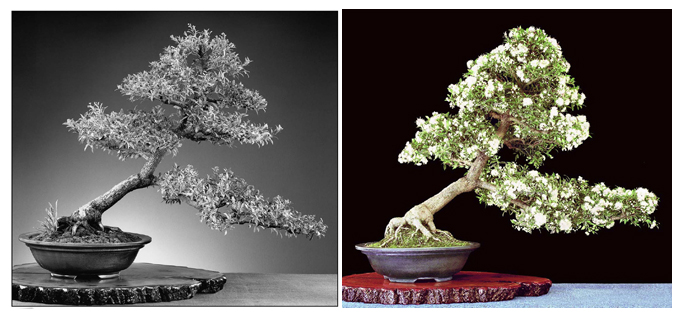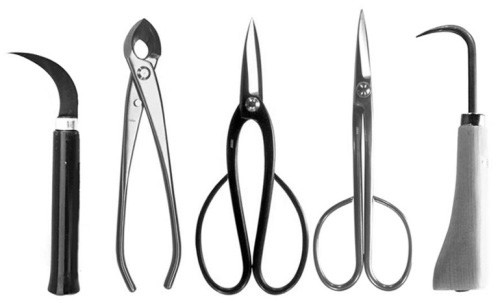You can find the color version of this Japanese white pine on the cover of our Masters' Series Pine book. The black and white version is the same image with the color photoshopped out. Though the B&W version does have it qualities, the vivid pot color and the robust green foliage provide a strong argument for shooting bonsai in color.
This post is a composite of two posts from 2012 with some thoughts added today. The attempt is to contrast B&W bonsai photos with color bonsai photos.
There are four types of photos here. Black and white photos. Color photos. B&W photos that were photoshopped from color photos. And one photo that was colorized from an old B&W photo and then photoshopped back to B&W.
Though color is the almost unanimous choice these days, there does seem to be something compelling about a good black and white photo. Maybe the stark quality of black and white highlights features that we might otherwise miss.
Here's a good one from flickr that was taken in B&W. It's starkly beautiful in B&W, especially the way the absence of color heightens awareness of light and shading. Also the texture of the foliage. It's titled Black and white bonsai tree, The Huntington library Japanese garden. My best guess is that it's a Shimpaku juniper grafted onto San Jose stock. Something you often see in Southern California. Especially at Chikugo en Bonsai Nursery.
This Pemphis acidula is called Snake Dance. The bonsai artist is Gede Merta. The black & white version was photoshopped.
Here's B&W full sized so you can get a better look. Without color and without much shading, it takes on a ghostly look.
From B&W to colorized and back. This one is titled Hangyoku with her bonsai tree (1905). You can get a feel for just how far bonsai has come in the last hundred plus years. The colorized version is from here. The B&W version was photoshopped from the colorized version.
Shot in B&W. These two photos by Morten Albek are what got me thinking about the value of black and white photos.
This photo, titled bonsai in black and white was shot in December 2009 at the National Arboretum by Brian Hefele. He was using a Sigma DP2.
Comments from Bonsai in Black & White part 1
Here are three of the comments from our first of our two original posts on B&W vs color. I think each one sheds some light (no pun intended) on our discussion.
During the punic wars, when I was in college studying photography, … Freshman and Sophomore students were only permitted to work in black and white. It wasn’t until the Junior year that they were permitted to enroll in color photographic courses. The psychology was that while color adds a great deal to a photo, it can also be a great distraction from the more important things a photographer needs to learn such as composition, use of light and shadow, texture, lighting, manipulation of depth of field, etc, etc. First and second year students needed to master these aspects of the photographic art and in the beginning, color was considered too much of a “distraction” for beginners to have to deal with.
Randy Clark
All to often people convert their color images to black and white and feel that they turned a ok picture into something better. In my opinion black and white photography takes a much greater understanding of light. I agree that a good black and white photo would highlight things that would otherwise be missed. I think it has to do with creating a balanced overall image (light, contrast, tonal range) would add light detail to areas otherwise lost in shadow. As is displayed with your examples. The picture of the shimpaku picks up a lot of detail but the picture of the pemphis becomes flat. I think this is an interesting topic that delves into another art form. Light and composition make a photo and sometimes what works in color doesn’t necessarily convert to black and white without considerable effort (photoshop). But hey that is just my opinion. Cool post.
Matt Logan
In traditional film photography black and white films were available that had very distinct contrast and gray response that color film often did not. That is why many of the older photos showed such exquisite detail. In modern digital photography I think the closest you can get to that range of contrast is with HD techniques, using multiple exposures of the same subject, but those are usually used with contrasty colors for eye candy. I think a serious photographer that was after the older B&W film effect with a good grasp of HD photography would have an avid audience in the bonsai market.
Zack Clayton
 Two photos from an article titled The Culture & Training of Dwarf Brush Cherry Bonsai that appeared in Bill Valavanis’ International Bonsai magazine. Color is clearly an advantage when it comes to flowers.
Two photos from an article titled The Culture & Training of Dwarf Brush Cherry Bonsai that appeared in Bill Valavanis’ International Bonsai magazine. Color is clearly an advantage when it comes to flowers.
 Can you tell if this photo of Koyo Bonsai Tools (now 25% off)
Can you tell if this photo of Koyo Bonsai Tools (now 25% off)
was shot in black & white or color?